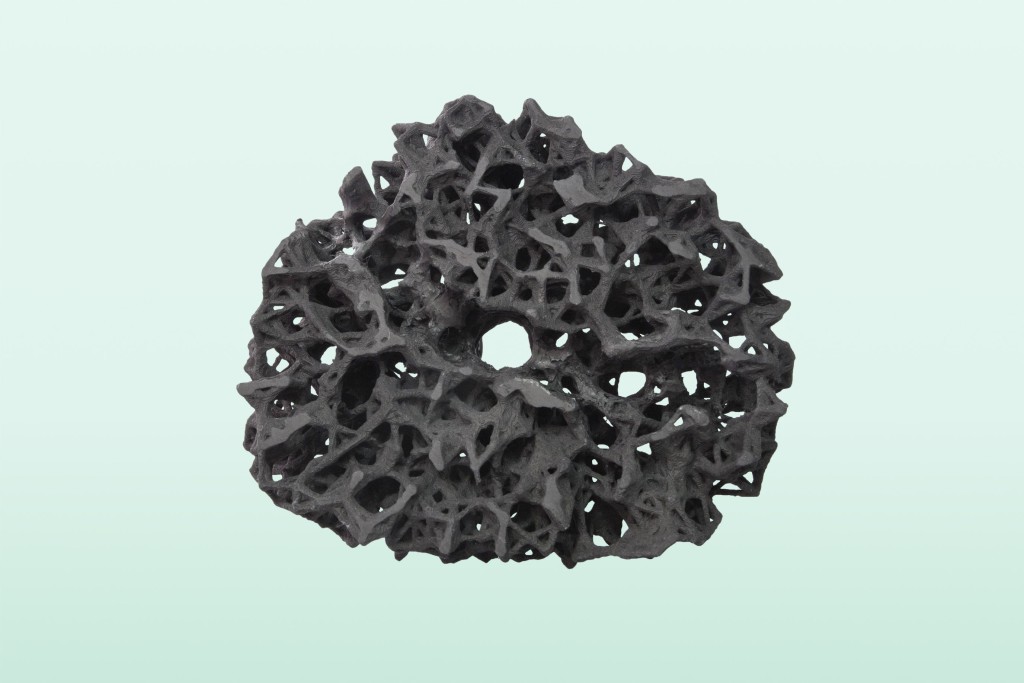Strategies employed include a speculative biology which envisions genetically manipulated bacteria generating crystals from the electromagnetic field surrounding electricity cables to “connect biological life to the electricity grid.” Another dossier on the story of phosphor takes us on a journey spanning the “entire socio-technical structure from phosphor mining and the global agribusiness to our plates and toilets.” Throughout the magazine strong artistic, multidisciplinary approaches – including a video work employing a Shakespearean actor and specially composed music – generate alternatives to the standard scientific narrative.
Technosphere Magazine’s front page shows a sponge-like, ring-shaped structure that looks like a fossil. What is it?
Katrin Klingan: It’s a photo of an organically evolving, yet artificial web. It’s part of a series developed by Studio NAND, the design agency we work with on the magazine.
Christoph Rosol: The idea behind it is that, along with developments in the field of synthetic biology – advanced genetic engineering – we are increasingly dealing with forms of life that are manipulated by us humans. But how do we feed and supply energy to this synthetic life form? The speculative process that led to the object on the home page, the magazine’s “cover,” is an attempt to connect biological life to the “power grid.”
How would that work?
Christoph Rosol: When power flows through a cable, it creates an electromagnetic field. So the designers used genetically engineered bacteria that are capable of forming magnetic crystals from the electrostatic field. Taking the thought experiment further, these crystals in turn could be used to transform the original energy of the electromagnetic field into a molecule called adenosine triphosphate, which is an energy-carrier for living cells.
Overcoming the gap between the biological and the technological is also the concept behind the technosphere …
Katrin Klingan: The term or word “technosphere” has been around for some time. Originally, it simply described technical infrastructures and systems. However, we’re talking about a broader phenomenon. The novelty that interests us is that the categorical separation of man, technology and nature no longer works.
Can you give me an example?
Christoph Rosol: Together, all life on Earth forms the biosphere. Life is not just the sum of the species; it also encompasses interactions between different living beings, metabolisms and energy exchanges. The technosphere is the analog version of this. It doesn’t simply sum up “technology,” but indicates how matter and energy circulate today. We move around by mobilizing and burning fossil energy sources that are millions of years old. We cultivate and harvest much of the available biomass of this planet. The constellation of humankind and nature materializes in the technosphere. It virtually forms the engine room of the Anthropocene.
The magazine describes the world of the technosphere by compiling individual articles in dossiers and putting them online all at once. There will be about twenty-five dossiers in the end. How do they work? Take the example of Phosphorus.
Christoph Rosol: The story of phosphorus is that this chemical element is vital to life. From this element, we can generate a complete socio-technical fabric – from phosphate mining and the global agricultural industry to our ceramic dinner plates and toilets seats. This takes us to the phosphate mines of Morocco or to the upheavals experienced by civilization in Pacific island states. We want to show the whole fabric. Not abstractly, but with references to specific places and times.
Katrin Klingan: The topic of phosphorus is a prime example of an exploratory research project as we practice it here at Haus der Kulturen der Welt (HKW). The authors who wrote the Phosphorus dossier were brought together originally at a HKW event, where they sketched out the “phosphorus apparatus” together. This collaboration continued in a workshop at the Rachel Carson Center in Munich, with a plan to publish both a special phosphorus issue in the journal published by the Center and then to develop a more visual, artistic dossier in our magazine. For this, we added designers who had already intensively dealt with the topic. We try to be not only event-oriented but also to work long-term, to lead the researcher–artist collaborations to results through multiple cycles and moments of focus.
How does the collaboration between the authors, designers and artists who also contribute to the dossiers work?
Katrin Klingan: For example, our author Jan Zalasiewicz chairs the Anthropocene Working Group of the International Commission on Stratigraphy. The artist he selected, graphic designer Anne-Sophie Milon, creates a space of possibility for Zalasiewicz that gives him a language and a narrative that differ from his usual scientific perspective. It’s much like a geology of the future using pencils and chalk.
Christoph Rosol: Another example: For the Phosphorus dossier, the designers hired a Shakespearean actor from London. The videos shown in the dossier begin with the fascination of discovering the element of phosphorus in an alchemistic context. It goes into other, darker areas: the depletion of phosphate, how dependent our agriculture and industry are on this resource, the overindulgence. Those are definitely theatrical moments! The music was also especially composed for it.
Katrin Klingan: It’s about the core element of alchemy, how the inner always struggles with the outer; how white gold, splendor, wealth, prosperity and poverty, exhaustion and collapse all interconnect.
What sort of readership does Technosphere Magazine target?
Christoph Rosol: We mainly address the kind of para-academic community that also showed an interest in the Anthropocene series at HKW. Ours is a largely international audience that moves between science, culture and a general interest in major contemporary issues. The spirit that drives our community is the collective use of different sources of knowledge that feed into a larger social discourse.
Katrin Klingan: We see ourselves as an exploratory project. This project takes place here at HKW, but also within a larger community. Scientists, artists and people from civil society are involved in it. The magazine is a shop window that gives insights into this work.
